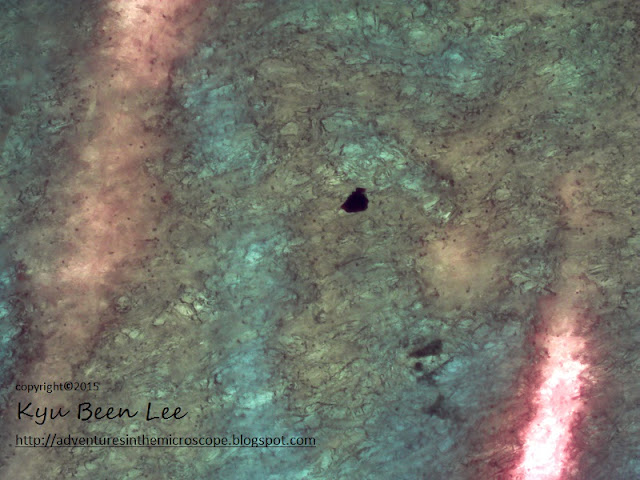 |
| banana iodine solution 40X |
When iodine, dissolved in potassium iodide, is mixed with starch, it creates a purple/blue color emitting the starch if there are any.
Here, the pictures show the large array of starches covering the banana when stained with iodine.
If there weren't any starch in the banana, the pictures would have been emitted with a brown color.
 |
| banana iodine solution 100X |
Just a word of advice but if you want an energy boost, it is best to consume bananas because of
their high concentration of starch. Starch's only function for the human body is to convert glucose into energy. It is actually broken down in your mouth to simpler carbohydrates called maltose.
 |
banana iodine solution 400X
|
James Kennedy, a high school chemistry teacher in Australia, created posters
showing the compounds in fruits and other natural foods to illustrate
that chemicals are an unremarkable part of life.
INGREDIENTS: WATER
(75%), SUGARS (12%) (GLUCOSE (48%),
FRUCTOSE
(40%), SUCROSE (2%), MALTOSE (<1%)), STARCH
(5%),
FIBRE E460 (3%), AMINO
ACIDS (GLUTAMIC ACID (19%),
ASPARTIC
ACID (16%), HISTIDINE (11%), LEUCINE (7%), LYSINE
(5%),
PHENYLALANINE (4%), ARGININE (4%), VALINE (4%),
ALANINE
(4%), SERINE (4%), GLYCINE (3%), THREONINE (3%),
ISOLEUCINE
(3%), PROLINE (3%), TRYPTOPHAN (1%), CYSTINE
(1%),
TYROSINE (1%), METHIONINE (1%)), FATTY
ACIDS (1%)
(PALMITIC
ACID (30%), OMEGA-6 FATTY ACID: LINOLEIC ACID
(14%),
OMEGA-3 FATTY ACID: LINOLENIC ACID (8%), OLEIC ACID
(7%),
PALMITOLEIC ACID (3%), STEARIC ACID (2%), LAURIC ACID
(1%),
MYRISTIC ACID (1%), CAPRIC ACID (<1%)), ASH (<1%),
PHYTOSTEROLS,
E515, OXALIC ACID, E300, E306
(TOCOPHEROL),
PHYLLOQUINONE, THIAMIN, COLOURS
(YELLOW-ORANGE
E101 (RIBOFLAVIN), YELLOW-BROWN E160a),
FLAVOURS (3-METHYLBUT-1-YL
ETHANOATE, 2-METHYLBUTYL
ETHANOATE,
2-METHYLPROPAN-1-OL, 3-METHYLBUTYL-1-OL, 2-
HYDROXY-3-METHYLETHYL
BUTANOATE, 3-METHYLBUTANAL,
ETHYL
HEXANOATE, ETHYL BUTANOATE,, PENTYL ACETATE),
1510,
NATURAL RIPENING AGENT (ETHENE GAS).





















































